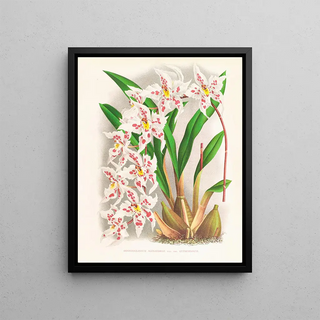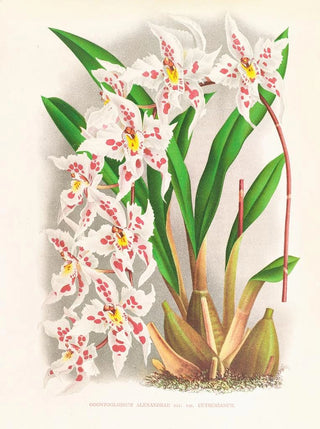Art print | Odontoglossum alexandrae var. cutsemianum - Jean Jules Linden


View from behind

Frame (optional)
Reproduction Odontoglossum alexandrae var. cutsemianum - Jean Jules Linden – Engaging introduction
The artwork "Odontoglossum alexandrae var. cutsemianum" by Jean Jules Linden is a true ode to natural beauty, capturing the essence of orchids with rare delicacy. Painted in the 19th century, this piece stands out for its striking realism and meticulous attention to detail. Each petal, each stem, seems to vibrate with its own life, inviting the viewer to immerse themselves in a world where nature and art meet harmoniously. This art print allows for rediscovering a masterpiece of botanical illustration, while highlighting Linden's undeniable talent, who managed to immortalize the splendor of exotic flowers with unparalleled sensitivity.
Style and uniqueness of the work
Jean Jules Linden's style is characterized by scientific precision combined with artistic sensitivity. In "Odontoglossum alexandrae var. cutsemianum," every detail is rendered with a meticulousness that demonstrates deep respect for the subject. The vibrant colors and delicate nuances of the petals blend with a subtly nuanced background, creating a contrast that highlights the beauty of the orchid. The composition, although centered on the flower, is balanced by surrounding natural elements, adding an extra dimension to the piece. This ability to combine aesthetics and accuracy makes this work a perfect example of 19th-century botanical art, where scientific observation transforms into a celebration of nature.
The artist and his influence
Jean Jules Linden, botanist and artist, left an indelible mark in the world of botanical illustration. Active during a period when the exploration of exotic plants was booming, Linden was able to capture not only the appearance of flowers but also their essence. His work was influenced by the journeys he undertook, notably in South America, where he discovered unique plant species. As a member of the scientific community, he contributed to documenting biodiversity, while establishing himself as a talented artist. His influence endures today, both in the field of art and in the

Matte finish

View from behind

Frame (optional)
Reproduction Odontoglossum alexandrae var. cutsemianum - Jean Jules Linden – Engaging introduction
The artwork "Odontoglossum alexandrae var. cutsemianum" by Jean Jules Linden is a true ode to natural beauty, capturing the essence of orchids with rare delicacy. Painted in the 19th century, this piece stands out for its striking realism and meticulous attention to detail. Each petal, each stem, seems to vibrate with its own life, inviting the viewer to immerse themselves in a world where nature and art meet harmoniously. This art print allows for rediscovering a masterpiece of botanical illustration, while highlighting Linden's undeniable talent, who managed to immortalize the splendor of exotic flowers with unparalleled sensitivity.
Style and uniqueness of the work
Jean Jules Linden's style is characterized by scientific precision combined with artistic sensitivity. In "Odontoglossum alexandrae var. cutsemianum," every detail is rendered with a meticulousness that demonstrates deep respect for the subject. The vibrant colors and delicate nuances of the petals blend with a subtly nuanced background, creating a contrast that highlights the beauty of the orchid. The composition, although centered on the flower, is balanced by surrounding natural elements, adding an extra dimension to the piece. This ability to combine aesthetics and accuracy makes this work a perfect example of 19th-century botanical art, where scientific observation transforms into a celebration of nature.
The artist and his influence
Jean Jules Linden, botanist and artist, left an indelible mark in the world of botanical illustration. Active during a period when the exploration of exotic plants was booming, Linden was able to capture not only the appearance of flowers but also their essence. His work was influenced by the journeys he undertook, notably in South America, where he discovered unique plant species. As a member of the scientific community, he contributed to documenting biodiversity, while establishing himself as a talented artist. His influence endures today, both in the field of art and in the






